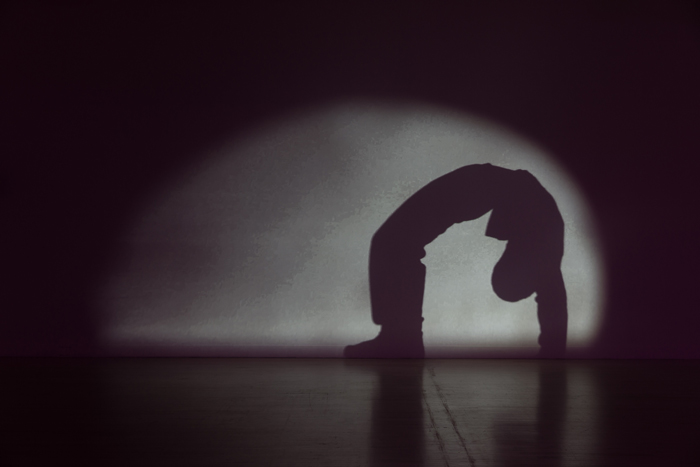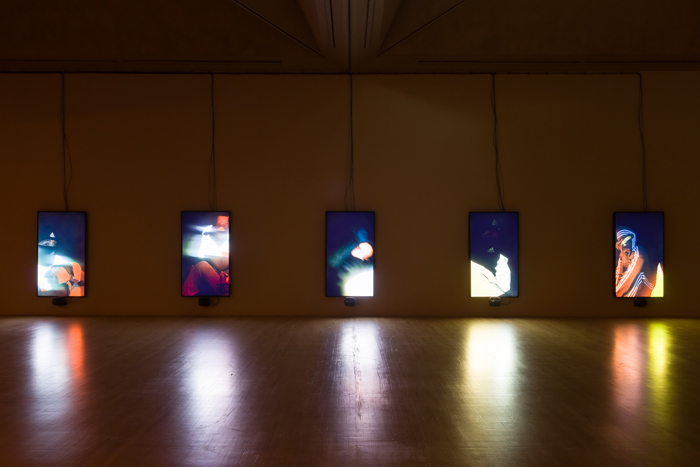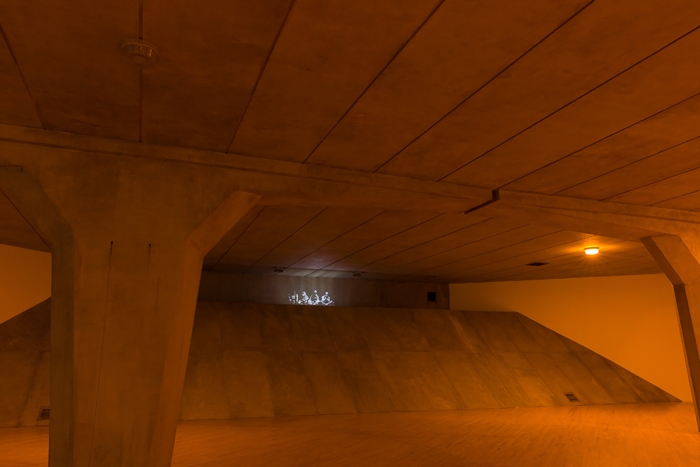Ecstasy and melancholy are different kinds of euphoria. When Johnny Rotten sang, in God Save the Queen (1977), that ‘England’s dreaming’, it wasn’t the psychedelic celebration of British suburbia of, say, The Beatles’ Penny Lane (1967), but an ironic, caustic admission of a darker sort of delirium. Mark Leckey’s show is part retrospective, embedded in history, and part future-fiction, where two earlier works – his seminal Fiorucci Made Me Hardcore (1999), and the more recent Dream English Kid 1964–1999 AD (2015) – are set against new works that suggest that society, and maybe history itself, has come unstuck: adrift and delirious.
Leckey has transformed the gallery into the concrete-vaulted underside of a motorway flyover, lit in gloomy, flickering, streetlight sodium-yellow. It’s the stage for a carefully choreographed sequence of these old and new works, which, son-et-lumière-style, light up in sequence around the space. This motorway underpass, with its concrete slope and supports, is a place Leckey has visited in various exhibitions over the last few years and as a visual marker which punctuates Dream English Kid. It seems to be a place fixed somewhere in Leckey’s inner world, a vision burnt into the memory of the little ‘kid’ who might be the film’s subject; a film that collages clips culled from mass culture into a kind of visual biography – of an individual and of a country during a period in history. It’s a flyover Leckey locates on the M53, near his childhood home in the Wirral, in the north of England.

Dream English Kid unspools a life lived through the 1960s, 70s and 80s in Britain, told in a sequence of hypnotic, often arresting images of everyday stuff, ordinary life and world events: the first test satellite for TV broadcast, the Beatles, the new motorways of postwar Britain, Eric’s club in Liverpool, degraded footage of Joy Division in concert there, atomic-war paranoia, the permed hairdos of nightclubbers, Birds Eye fish-fingers, Cinzano Rosso ads, airliners shot down by the Soviets, terrorist bombings. It ends up somewhere in London, between a lunar eclipse in 1992 and the solar eclipse of 1999. Its timeline – from the year of Leckey’s birth to his moving to London and later making Fiorucci – allows it to segue into that work, a celebration of British urban subculture from Northern Soul dancers gyrating in slow motion, through to the accelerated, E-fuelled intensity of rave culture.
These works are only partly social documentary – what really drives Leckey’s films is the pleasure and the horror of looking, the need to remember, and the borderline at which selfhood and self-obliteration meet in the (often erotic) fascination for an image. A pivotal sequence in Dream English Kid is a voyeuristic borrowing of a film clip in which a blonde woman, maybe a 1960s nightclub hostess, is in her underwear, doing her make up in a vanity mirror. The grid of her fishnet tights becomes the analogue of a grid of TV dots, before the little boy seen earlier makes a shadowy appearance in the mirror.


Mark Leckey: O’ Magic Power of Bleakness, 2019 (installation views, Tate Britain, London). Photo: Mark Blower. Courtesy the artist
If presenting Dream English Kid and Fiorucci is more than just career-retrospective routine, it’s because they set up a sort of prehistory for the new work, Under Under In (2019). A five-screen video, it’s a weird, phone-cam world of shadowy teenagers dressed in Adidas-branded hoods, cowls and facemasks, like futurised medieval peasants. They congregate up on the cramped ledge in the eaves of the bridge. The loose narrative is of one of their number being abducted by a ‘fairy’; he then returns, but is somehow transformed, and after a session of spray-can sniffing, the group spiral into a drugged delirium, which allows them to descend into the earth, through ghostly computer-generated renditions of the bridge itself, then down through visions of what might be earlier structures that have spanned the same place in past centuries, ending with Neolithic standing stones and the dark passages of what might be a barrow. At the end, the little group, projected like ghosts up on the concrete ledge of actual bridge in the gallery, contort themselves into walking on all fours, backward-arching, as if they have become possessed by the idea of the bridge, so much so that they become like it.
Leckey’s post-history finale says goodbye to the subcultures and the social life of working-class Britain. It is at least honest. Flickering in the digital light of their smartphones, the young nomads of Under Under In only have the motorway bridge as a home, and the urban, social world that framed the earlier films has vanished. Motorways have a strong place in dystopian visions: Brian Aldiss’s novel Barefoot in the Head (1969) imagines a collapsed Europe, in which LSD casualties roam the still-standing continental motorway networks; J.G. Ballard’s Crash (1973) is fascinated by the elevated road structures of London’s Westway; Einstürzende Neubauten’s first album, Kollaps (1981), was supposed to have been recorded in a space hidden in the concrete bowels of a Berlin flyover; and the last frames of Alan Moore’s comic V for Vendetta (1982–88) see policeman Finch leave the ruins of London, after the downfall of the fascist dictatorship, as he walks off into the unlit darkness of a deserted M1, heading north. Leckey’s under-bridge is a place where history has ground to a halt, rather than a point of transit through it. If O’ Magic Power of Bleakness feels like a strangely timely show, it’s because the question that hangs in the air, outside, is ‘where next?’
Mark Leckey: O’ Magic Power of Bleakness is on view at Tate Britain, London, through 5 January 2020
Online exclusive, published on 27 September 2019
